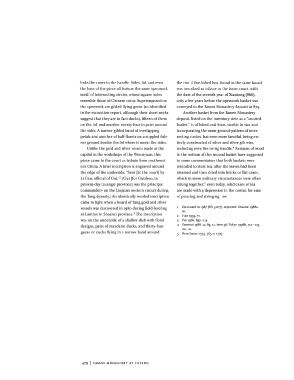Page 480 - The Golden Age of Chinese Archaeology: Celebrated Discoveries from the People’s Republic of China
P. 480
links the cover to the handle. Sides, lid, and even the rim. A five-lobed box, found in the same hoard,
the base of the piece all feature the same openwork was inscribed as tribute to the inner court, with
motif of intersecting circles, whose square holes the date of the seventh year of Xiantong (866),
resemble those of Chinese coins. Superimposed on only a few years before the openwork basket was
the openwork are gilded flying geese (so identified conveyed to the Famen Monastery deposit in 874.
in the excavation report, although their short necks Another basket from the Famen Monastery
suggest that they are in fact ducks), fifteen of them deposit, listed on the inventory stele as a "knotted
on the lid, and another twenty-four in pairs around basket," is of lobed oval form, similar in size and
the sides. A narrow gilded band of overlapping incorporating the same ground-pattern of inter-
petals and another of half-florets on a stippled fish- secting circles, but even more fanciful, being en-
roe ground border the lid where it meets the sides. tirely constructed of silver and silver-gilt wire,
4
Unlike the gold and silver vessels made at the including even the swing handle. Remains of wood
capital in the workshops of the Wensiyuan, this in the bottom of this second basket have suggested
piece came to the court as tribute from southwest- to some commentators that both baskets were
ern China. A brief inscription is engraved around intended to store tea, after the leaves had been
the edge of the underside: "Sent [to the court] by steamed and then dried into bricks or flat cakes,
2
Li Can, official of Gui." (Gui [for Guizhou, in which in more ordinary circumstances were often
5
present-day Guangxi province] was the principal strung together; even today, solid cakes of tea
commandery on the Lingnan western circuit during are made with a depression in the center, for ease
the Tang dynasty.) An identically worded inscription of piercing and stringing. RW
came to light when a hoard of Tang gold and silver
vessels was discovered in 1980 during field-leveling 1 Excavated in 1987 (FD 5:077), reported: Shaanxi 19883,
3
at Lantian in Shaanxi province. The inscription 2 16. 1995, 71.
Han
was on the underside of a shallow dish with floral 3 Fan 1982, figs. 2, 9.
designs, pairs of mandarin ducks, and thirty-four 4 Famensi 1988,12, fig. 12, item 36; Tokyo 1998!}, 172-173,
no. in.
geese or ducks flying in a narrow band around 5 Reischauer 1955, 365 n. 1395.
479 FAMEN MONASTER Y AT FUFENC

